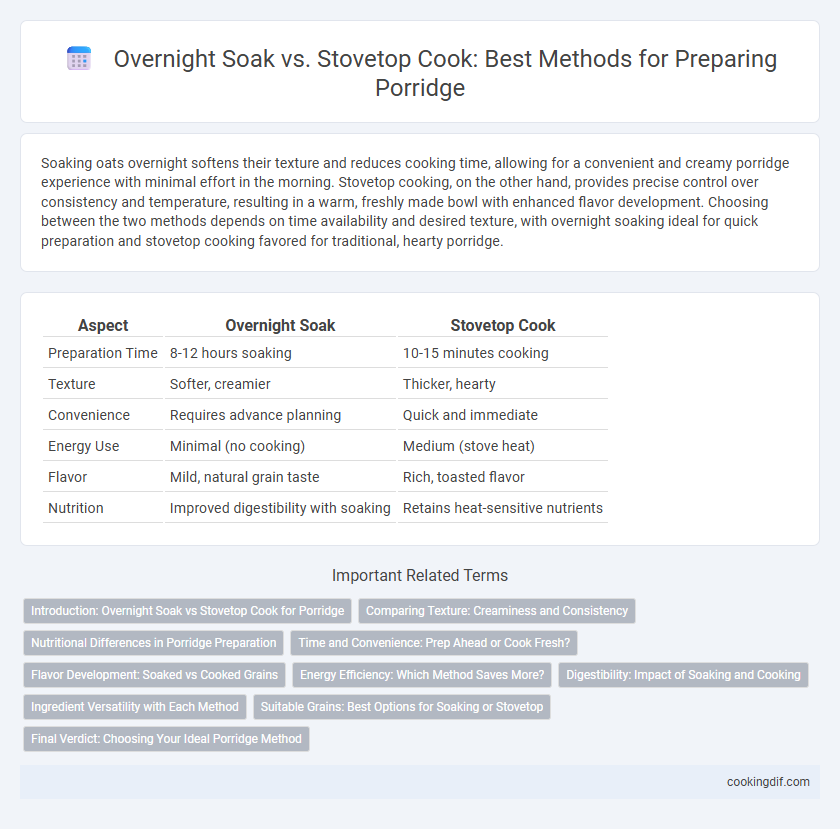Soaking oats overnight softens their texture and reduces cooking time, allowing for a convenient and creamy porridge experience with minimal effort in the morning. Stovetop cooking, on the other hand, provides precise control over consistency and temperature, resulting in a warm, freshly made bowl with enhanced flavor development. Choosing between the two methods depends on time availability and desired texture, with overnight soaking ideal for quick preparation and stovetop cooking favored for traditional, hearty porridge.
Table of Comparison
| Aspect | Overnight Soak | Stovetop Cook |
|---|---|---|
| Preparation Time | 8-12 hours soaking | 10-15 minutes cooking |
| Texture | Softer, creamier | Thicker, hearty |
| Convenience | Requires advance planning | Quick and immediate |
| Energy Use | Minimal (no cooking) | Medium (stove heat) |
| Flavor | Mild, natural grain taste | Rich, toasted flavor |
| Nutrition | Improved digestibility with soaking | Retains heat-sensitive nutrients |
Introduction: Overnight Soak vs Stovetop Cook for Porridge
Overnight soaking of oats enhances nutrient absorption and reduces cooking time by allowing the grains to soften in liquid, resulting in a creamier texture. In contrast, stovetop cooking delivers immediate warmth and a traditional porridge consistency through direct heat, which activates starches for a thicker, heartier meal. Choosing between these methods depends on preference for convenience versus freshness and texture in porridge preparation.
Comparing Texture: Creaminess and Consistency
Overnight soaking softens oats by allowing them to absorb liquid gradually, resulting in a creamier and smoother porridge texture with a consistent thickness. Stovetop cooking, on the other hand, uses heat to break down the oats quickly, producing a thicker, heartier texture with a slightly chewy mouthfeel. The choice between soaking and cooking significantly affects the porridge's creaminess, with soaked oats yielding a more velvety consistency and stovetop methods providing a denser, more substantial texture.
Nutritional Differences in Porridge Preparation
Overnight soaking of oats preserves more of their vitamins, such as B-complex and antioxidants, by minimizing heat exposure that can degrade sensitive nutrients. Stovetop cooking increases bioavailability of certain minerals like iron and zinc through heat-induced breakdown of phytic acid but may reduce heat-sensitive vitamins and antioxidants. Each method impacts the nutritional profile differently, with soaking enhancing enzymatic activity and digestibility while cooking improves mineral absorption.
Time and Convenience: Prep Ahead or Cook Fresh?
Overnight soak porridge saves morning time by softening oats in liquid for several hours, allowing quick, no-cook assembly, ideal for busy schedules or grab-and-go meals. Stovetop cook porridge requires active preparation and about 5-10 minutes cook time, offering fresh, warm texture and flavor but less convenience for early mornings. Choosing between prep ahead or cook fresh depends on prioritizing time efficiency versus immediate taste preference in porridge preparation.
Flavor Development: Soaked vs Cooked Grains
Soaking porridge oats overnight enhances enzymatic activity, leading to increased natural sweetness and a smoother texture compared to stovetop cooking, which often results in a robust, nutty flavor due to Maillard reactions. Overnight soaking also reduces phytic acid content, improving mineral absorption and digestibility. Conversely, stovetop cooking intensifies the grain's toasted notes, creating a heartier flavor profile preferred in traditional porridge recipes.
Energy Efficiency: Which Method Saves More?
Overnight soaking porridge significantly reduces stovetop cooking time, resulting in lower overall energy consumption compared to traditional stovetop cooking from dry grains. By softening grains ahead of time, the stovetop method requires less heat and shorter duration, optimizing energy efficiency. Energy-saving metrics indicate that overnight soak combined with brief stovetop cooking can cut energy usage by up to 50% compared to cooking porridge solely on the stove.
Digestibility: Impact of Soaking and Cooking
Overnight soaking of grains for porridge enhances digestibility by initiating enzymatic activity that breaks down phytic acid and complex starches, making nutrients more bioavailable. Stovetop cooking further improves digestion by gelatinizing starches and softening fibers, facilitating easier breakdown during digestion. Combining soaking and stovetop cooking maximizes nutrient absorption and reduces digestive discomfort often associated with unprocessed grains.
Ingredient Versatility with Each Method
Overnight soak porridge allows grains like oats, quinoa, and chia seeds to absorb liquid fully, enhancing texture and flavor without heat, making it ideal for nutrient-rich additions such as fresh fruits, nuts, and seeds. Stovetop cooking suits a wider variety of grains, including steel-cut oats and barley, offering the flexibility to incorporate dairy, spices, and sweeteners during the cooking process for a creamier, customizable porridge. Each method maximizes ingredient versatility by tailoring texture and flavor profiles to personal preferences and nutritional needs.
Suitable Grains: Best Options for Soaking or Stovetop
Steel-cut oats and barley are ideal for stovetop cooking due to their dense texture, which softens effectively under direct heat. Rolled oats and quinoa excel with overnight soaking, as they absorb liquid and soften sufficiently without cooking, offering a convenient, ready-to-eat texture by morning. Buckwheat groats suit both methods, allowing flexibility for either a creamy stovetop porridge or a quick soaked option with a tender bite.
Final Verdict: Choosing Your Ideal Porridge Method
Overnight soak porridge offers convenience and a smoother texture by softening grains ahead of time, enhancing digestibility and reducing cooking duration. Stovetop cooking allows precise control over consistency and temperature, delivering a freshly prepared, warm porridge with customizable thickness. Selecting the ideal method depends on lifestyle preferences, texture desired, and nutritional goals, with overnight soaking suited for busy mornings and stovetop cooking preferred for immediate, hearty meals.
overnight soak vs stovetop cook for porridge preparation Infographic

 cookingdif.com
cookingdif.com